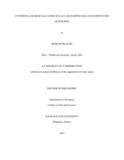Please use this identifier to cite or link to this item:
http://archive.nnl.gov.np:8080/handle/123456789/296| Title: | Synthesis and bioevaluation of laccase substrates and substituted quinolines |
| Authors: | Prasain, Keshar |
| Keywords: | Laccase substrate activity Antilarval activity Phosphorylation Quinolines |
| Issue Date: | 25-Feb-2018 |
| Abstract: | Our research work is divided into three chapters. In the first chapter, synthesis of substituted phenolic compounds including halogenated di- and trihydroxybenzenes, aminophenols, and substituted di-tert-butylphenols, their redox potential, laccase oxidation, and mosquito anti-larval activities are discussed. The synthesized substituted phenols were found to be the substrates but not the inhibitors of laccase. An inverse correlation between the oxidation potential and the laccase oxidation efficiency of halogenated hydroxybenzenes and aminophenols was established. However, substituted di-tert-butylphenols were found to have anti-larval activities in mosquitoes resulting in the death of the larvae just before reaching pupation. Among the di-tert-butyl phenols studied, water insoluble, 2,4-di-tert-butyl-6-(3-methyl-2-butenyl)phenol (16), 2-(3,5-di-tert-butyl-4-hydroxyphenyl)-2-methylpropanal oxime (14), and 6,8-di-tert-butyl-2,2-dimethyl-3,4-dihydro-2H-chromene (17) caused the mortility of 98%, 93%, and 92% of Anopheles gambiae larvae in the concentration of 182 nM, 3.4 μM, and 3.7 μM, respectively. In particular, compound 16 had similar anti-larval activities as compared to MON-0585, an anti-larval agent reported by Monsanto in the 70’s. In the second chapter, inhibition of protein kinase C (PKC) phosphorylation by substituted quinolines (PQs) is inverstigated. PQ compounds such as N-(3-aminopropyl)-6-methoxy-4-methyl-5-(3-(trifluormethyl)phenoxy)quinolin-8-amine (PQ1), N-(furan-2-ylmethyl)-6-methoxy-4-methyl)-5-(3-(trifluoromethyl)phenoxy)quinolin-8-amine (PQ11), and 6-methoxy-4-methyl-N-(quinolin-4-ylmethyl)-5-(3-(trifluoromethyl)phenoxy)quinolin-8-amine (PQ15) were found to inhibit PKC phosphorylation with IC50 values of 35 nM, 42.3 nM, and 216.3 nM respectively, among which PQ1 and PQ11 were found to be potent PKC inhibitors as comparable to that of staurosporine (IC50 = 33 nM). In chapter three, the tissue distribution of PQ1 and PQ11 in normal C57BL/6J mice and the effect of PQ1 on the normal tissues of mice were investigated. Substituted quinolines, PQ1 and PQ11 were distributed in the tissues in concentrations that were more than 40 folds of their effective dose. PQ1 and PQ11 were also found to penetrate the blood brain barrier and collect in the tissue in significant amounts. The administration of PQ1 and PQ11 had no effect in the normal behavior of the animals indicating no short term adverse effects. PQ1 was found to increase the expression of survivin, an anti-apoptotic factor and decrease the expression of cleaved caspase-3 and caspase-8, pro-apoptotic proteins. These studies suggests that PQ1 might have anti-apoptotic activities in normal cells, in contrast to the role of PQ1 in cancer cells where it has demonstrated to induce apoptosis. The study also indicated that PQ11 was better metabolized from the tissues over time as compared to PQ1. |
| Description: | A dissertation submitted in partial fulfillment of the requirements for the degree, Doctor of Philosophy, Department of Chemistry, College of Arts and Sciences, Kansas State University, Manhattan, Kansas, 2013. |
| URI: | http://103.69.125.248:8080/xmlui/handle/123456789/296 |
| Appears in Collections: | 500 Natural sciences and mathematics |
Files in This Item:
| File | Description | Size | Format | |
|---|---|---|---|---|
| PhD Thesis Keshar Prasain.pdf | 7.47 MB | Adobe PDF |  View/Open |
Items in DSpace are protected by copyright, with all rights reserved, unless otherwise indicated.